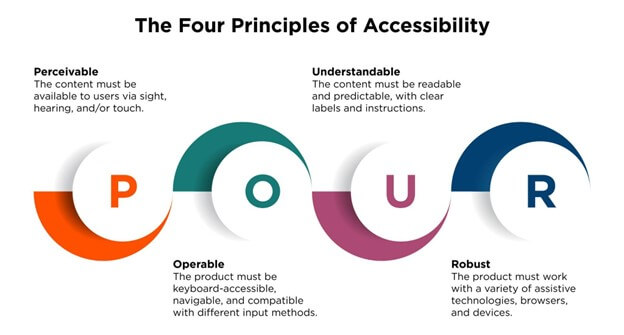Designing products with accessibility standards, specifically the Web Content Accessibility Guidelines (WCAG), is an important aspect of creating inclusive and user-friendly products. These guidelines provide a set of standards to ensure that individuals with disabilities can access and use your product, improving their overall user experience. As more and more people rely on technology for daily activities, it’s critical to ensure that everyone, regardless of ability, can use your product.
To design products with accessibility standards, you must have a clear understanding of the WCAG guidelines and their success criteria. This includes making keyboard navigation possible, providing alternative text for images, ensuring sufficient color contrast, making forms accessible, and providing accessible video and audio content.
By adhering to these guidelines, you can create a product that is widely available and more accessible to individuals with disabilities, such as, hard of hearing, mobility impairments or cognitive impairments. The focus of this blog is on designing products with accessibility in mind, utilizing the WCAG guidelines as a basis. We will examine essential principles and methods for developing accessible products and also offer guidance on testing and guaranteeing accessibility in your designs.
What is WCAG?
WCAG stands for Web Content Accessibility Guidelines, and it is a set of guidelines developed by the World Wide Web Consortium (W3C). These guidelines provide a standard for making web content accessible to people with disabilities, including those with visual, auditory, physical, speech, cognitive, and neurological disabilities.
The guidelines cover a wide range of web content, including text, images, audio, and video, and are designed to be technology-neutral. They provide a framework for designers and developers to create content that is perceivable, operable, understandable, and robust. WCAG 2.1 is the latest version of the guidelines, released in 2018, and it has three levels of conformance: A, AA, and AAA.

- Level A – Basic accessibility features that are considered essential for some users with disabilities are required at the minimum level of conformance. Meeting level A means that your digital product development has taken the first step towards being accessible to users with disabilities.
- Level AA – This level is a higher standard of accessibility compliance than level A. Meeting level AA requires not only the basic accessibility features outlined in level A but also additional measures that address more complex accessibility issues. Meeting level AA means that your digital product is more accessible to a wider range of users with disabilities.
- Level AAA – This level is the highest standard of accessibility compliance. Meeting level AAA requires the most comprehensive accessibility measures, including additional features and options that make the digital product even more accessible to users with disabilities. While meeting level AAA is not always feasible, it ensures that your digital product is as accessible as possible to all users, including those with the most complex accessibility needs.
Importance of WCAG for Designing Accessible Digital Products
- Ensures Accessibility for People with Disabilities – WCAG provides a framework to ensure that digital content is accessible to people with disabilities, including those with visual, auditory, physical, speech, cognitive, and neurological disabilities. Designers and developers can create content that can be accessed by a wide range of people, including those using assistive technologies like screen readers, braille displays, and keyboard-only navigation, by following WCAG guidelines.
- Provides a Framework for Creating Accessible Content – WCAG guidelines provide a framework for designers and developers to create content that is perceivable, operable, understandable, and robust. The World Wide Web Consortium (W3C) designed the guidelines to be technology-neutral, and they cover a wide range of web content, including text, images, audio, and video.
- Benefits Organizations – In addition, accessible content benefits organizations by increasing usability and search engine optimization (SEO). This means that accessible content is not only easier to use for everyone, including non-disabled users, but also more likely to be ranked higher in search engines.
- Legal Requirements – Creating accessible content is often a legal requirement in many countries, including the United States, Canada, and the European Union. Failure to comply with accessibility laws can result in legal action, fines, and damage to an organization’s reputation.
- Creates a More Inclusive Digital World – Following WCAG guidelines helps to create a more inclusive digital world for all users. By ensuring accessibility compliance for people with disabilities, digital content becomes more accessible to everyone, regardless of their abilities.
Overall, WCAG is essential for designing digital accessibility products that are usable, accessible, and legally compliant. By following these guidelines, designers and developers can create a more inclusive digital world for all users.
Understanding WCAG Guidelines: A Deeper Dive into Accessibility Standards for Digital Product Design
The Web Content Accessibility Guidelines (WCAG) provide a set of standards for creating accessible digital content. These guidelines are designed to ensure that all individuals, including those with disabilities, can access and use digital products with ease. The guidelines are organized into four principles: perceivable, operable, understandable, and robust. Each principle includes specific guidelines that outline how to create accessible content.

- Perceivable: This principle requires that digital content is presented in a way that can be perceived by all users. Moreover, this includes providing alternative text for images and other non-text content. This also ensures that text is easily readable, and makes sure that multimedia content is accessible.
- Operable: This principle ensures that all functions of a digital product can be accessed and used by all users, including those who may not be able to use a mouse. This includes providing keyboard accessibility, ensuring that content is easy to navigate, and avoiding content that may cause seizures.
- Understandable: This principle requires that digital content is presented in a way that is easy to understand for all users. This includes using clear and concise language, providing instructions that are easy to follow, and avoiding content that may be confusing or distracting.
- Robust: This principle ensures digital content is compatible with a wide range of technologies. It includes using standard coding practices and avoiding inaccessible technologies. Content should be compatible with different browsers and devices, including assistive technologies like screen readers and magnifiers.
By understanding the WCAG guidelines and incorporating them into your design process, you can create digital products that are accessible to a wider range of users, including those with disabilities.
Also Read: Growing Value of Enterprise Design Thinking for Business Innovation
User Research in Designing Accessible Products: Importance and Methods
User research is crucial to designing accessible products. It helps designers and developers understand the needs, preferences, and challenges of people with disabilities. By gathering insights from users with disabilities, designers and developers can create inclusive, usable, and effective products for everyone.
Reasons Why User Research is Important in Designing Accessible Products
- Identifying User Needs – User research helps to identify the needs and preferences of people with disabilities, such as how they access and use digital content. This information can help designers and developers to create products that are tailored to the specific needs of their target audience.
- Testing for Accessibility – Use user research to test the accessibility of digital products, such as websites and mobile applications. By testing with users with disabilities, designers and developers can identify accessibility barriers and make necessary changes to improve accessibility.
- Providing Insights for Inclusive Design – User research can provide valuable insights for inclusive design. An inclusive design involves designing products that are accessible and usable for all users. By involving users with disabilities in the design process, designers and developers can create products that are more inclusive and accessible for everyone. This approach can result in more effective products that better meet the needs of all users.
Examples of User Research Methods Used to Gather Insights from People with Disabilities
- Interviews – Use interviews to gather in-depth insights from people with disabilities about their experiences with digital products. These insights can help designers and developers to understand the specific needs and challenges of their target audience.
- Surveys – Use surveys to gather quantitative data about the accessibility and usability of digital products for people with disabilities. You can also use surveys to gather demographic information about users with disabilities, such as their age, gender, and type of disability.
- Usability Testing – Usability testing involves observing users as they interact with a digital product to identify usability and accessibility issues. This method can provide valuable insights into how people with disabilities access and use digital products.
- Focus Groups – Conduct focus groups to gather insights from a group of people with disabilities about their experiences with digital products. This method can provide valuable insights into common accessibility issues and preferences among users with disabilities.
Overall, user research is a crucial component of designing accessible products. By involving people with disabilities in the design process, designers and developers can create products that are more inclusive, usable, and effective for everyone.
Prioritizing Accessibility Standards in Design Practices
Prioritizing accessibility in design is crucial to ensure that digital products are usable and effective for all users, including those with disabilities.
Here are some specific design practices that can prioritize accessibility:
- Clear and Consistent Navigation – Navigation should be clear and consistent throughout the digital product. This further allows users to easily find and access the content they need.
- Font Readability – Fonts should be easy to read, with a minimum size of 14 points to ensure that the text is legible for all users. It is best to recommend using sans-serif fonts as they are easier to read on screens than serif fonts.
- High-Contrast Color Schemes – To ensure that text and other content are easily visible to all users, use high-contrast color schemes. We recommend a contrast ratio of at least 4.5:1 between the text and background for most text, while a ratio of 7:1 is recommended for large text.
- Alternative Text for Images – Alternative text (alt text) should be provided for images to ensure that users with visual disabilities can understand the content. Alt text should describe the purpose or function of the image, rather than its appearance.
- Keyboard Accessibility – Design digital products for keyboard-only navigation. Some users with disabilities rely on it instead of a mouse. All interactive elements should be keyboard-accessible, and focus should be visible to indicate the current element in focus.
- Captioning and Transcripts – To ensure that users with auditory disabilities can access the content, it is important to caption or transcribes videos and other multimedia content. Additionally, captions should be synchronized with the audio or video, and transcripts should be provided for all multimedia content.
Putting accessibility first in design ensures that people of all abilities can fully take advantage of digital products.
Testing for Accessibility: Types, Tools, and Techniques
Accessibility testing is crucial to making sure digital products are useful for everyone. You can do it in a number of different ways, such as:
- Automated Testing – Automated testing involves the use of software tools to test for accessibility issues. These tools can scan web pages and digital products to identify potential accessibility issues, such as missing alt text, incorrect heading structures, and insufficient color contrast.
- Manual Testing – Manual testing involves human testers with disabilities using digital products to identify accessibility issues. Testers can use a variety of assistive technologies, such as screen readers and magnifiers, to test digital products for accessibility.
- User Testing – User testing involves recruiting users with disabilities to test digital products and provide feedback on accessibility issues. User testing can identify usability issues that automated or manual testing may not catch.
- Accessibility Tools – There are a variety of tools available to assist with accessibility testing, including browser extensions and standalone applications. Such tools can help identify accessibility issues and provide suggestions for improving accessibility.
- Accessibility Standards – Accessibility standards, such as the Web Content Accessibility Guidelines (WCAG), provide a framework for designing accessible digital products. Testing against these standards can ensure that digital products meet established accessibility guidelines.
Tools That Can Be Used for Testing Accessibility

- Screen Readers – Screen readers are software programs that read aloud the content of a website or application to users with visual disabilities. Examples of screen readers include JAWS, NVDA, and VoiceOver.
- Color Contrast Checkers – You can use color contrast checkers to evaluate the contrast between text and background colors. Examples of color contrast checkers include WebAIM’s Contrast Checker and Color Contrast Analyzer.
- Keyboard Testing Tools – Keyboard testing tools can help you evaluate the accessibility of a digital product via keyboard-only navigation. Examples of keyboard testing tools include Keyboard Accessibility Checker and Tenon.io.
Developers can use a combination of automated and manual testing to thoroughly test digital products for accessibility issues. They can also incorporate user testing and accessibility tools to improve the testing process. Prioritizing accessibility testing is essential for making digital products usable for everyone.
Using Feedback from Testing to Improve Accessibility in Design
Feedback from testing is a critical part of the iterative design process. Designers and developers can analyze feedback from testing. They can identify areas where the product falls short in terms of accessibility. Then, they can make changes to improve its usability for all users.

To improve accessibility, designers, and developers can use feedback from testing in various ways:
- Prioritizing Fixes – Designers and developers can use feedback from testing to identify and address the most critical accessibility issues. Prioritize fixes based on severity and user impact. Address the most pressing accessibility issues first. To ensure that the team focuses on the most important issues, it’s important to first prioritize fixes based on severity and impact on users.
- Collaborating with Accessibility Experts – Designers and developers can work closely with accessibility experts to analyze feedback and improve accessibility. Specifically, they can collaborate during the design process to identify potential accessibility barriers and develop solutions to address them. This partnership can help ensure that accessibility is considered throughout the design and development process. Resulting in products that are more inclusive and accessible for all users.
- Conducting Ongoing Testing – Incorporating ongoing testing is essential to ensure continuous improvement in the iterative design process.
Therefore, feedback is crucial for improving digital product accessibility. Prioritizing fixes, collaborating with experts, and conducting ongoing testing ensures accessibility for all users.
To Sum Up
In today’s digital age, designing products with accessibility standards is more important than ever. By following WCAG and incorporating accessibility into your design process, your digital products can be usable by all individuals. This includes individuals with disabilities, older users, and those using assistive technologies.
To design accessible digital products, it’s important to understand the WCAG guidelines and incorporate them into your design process. To ensure inclusive design, it is important to consider various aspects such as permeability, operability, understandability, and robustness. You can make iterative improvements to your designs by incorporating feedback from accessibility testing. This will ensure that your products are accessible to as many users as possible.
Designing products with accessibility in mind benefits users and can lead to more successful products. By making your digital products more accessible, you can reach a wider audience and also create a more inclusive user experience. To ensure accessibility in your product design, it’s important not to overlook it. Binmile, a qualified software development company has a proven track record of delivering software solutions worldwide. Moreover, they can help you create accessible digital products. Schedule a call with our experts today to learn more.










